Marrying Vega and Zen: The AMD Ryzen 5 2400G Review
by Ian Cutress on February 12, 2018 9:00 AM ESTBenchmarking Performance: CPU System Tests
Our first set of tests is our general system tests. These set of tests are meant to emulate more about what people usually do on a system, like opening large files or processing small stacks of data. This is a bit different to our office testing, which uses more industry standard benchmarks, and a few of the benchmarks here are relatively new and different.
All of our benchmark results can also be found in our benchmark engine, Bench.
PDF Opening
First up is a self-penned test using a monstrous PDF we once received in advance of attending an event. While the PDF was only a single page, it had so many high-quality layers embedded it was taking north of 15 seconds to open and to gain control on the mid-range notebook I was using at the time. This put it as a great candidate for our 'let's open an obnoxious PDF' test. Here we use Adobe Reader DC, and disable all the update functionality within. The benchmark sets the screen to 1080p, opens the PDF to in fit-to-screen mode, and measures the time from sending the command to open the PDF until it is fully displayed and the user can take control of the software again. The test is repeated ten times, and the average time taken. Results are in milliseconds.
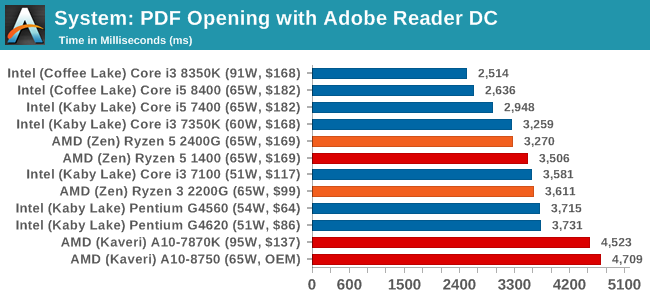
Our PDF test relies mostly on single core frequency, but memory frequency can also help. The 2400G pips the 1400, and the older AMD processors take a back seat. This is the sort of test that Intel's 4.2 GHz chips can take advantage off, as shown by the Core i3-8350K.
FCAT Processing: link
One of the more interesting workloads that has crossed our desks in recent quarters is FCAT - the tool we use to measure stuttering in gaming due to dropped or runt frames. The FCAT process requires enabling a color-based overlay onto a game, recording the gameplay, and then parsing the video file through the analysis software. The software is mostly single-threaded, however because the video is basically in a raw format, the file size is large and requires moving a lot of data around. For our test, we take a 90-second clip of the Rise of the Tomb Raider benchmark running on a GTX 980 Ti at 1440p, which comes in around 21 GB, and measure the time it takes to process through the visual analysis tool.
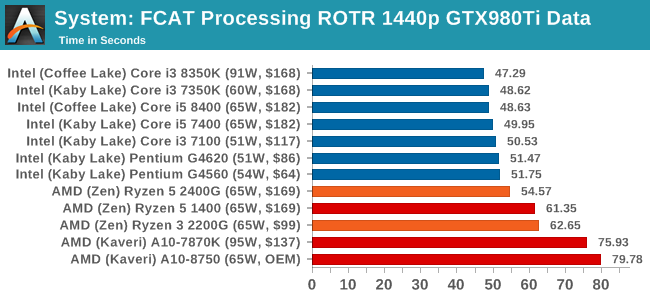
The FCAT program is single threaded, so again Intel's chips take a win here. The Ryzen 5 2400G takes another chunk out of the Ryzen 5 1400, due to its higher frequency.
Dolphin Benchmark: link
Many emulators are often bound by single thread CPU performance, and general reports tended to suggest that Haswell provided a significant boost to emulator performance. This benchmark runs a Wii program that ray traces a complex 3D scene inside the Dolphin Wii emulator. Performance on this benchmark is a good proxy of the speed of Dolphin CPU emulation, which is an intensive single core task using most aspects of a CPU. Results are given in seconds, where the Wii itself scores 1,052 seconds (17.53 minutes).
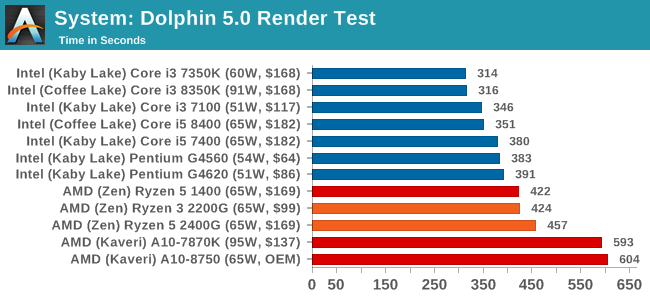
3D Movement Algorithm Test v2.1: link
This is the latest version of the self-penned 3DPM benchmark. The goal of 3DPM is to simulate semi-optimized scientific algorithms taken directly from my doctorate thesis. Version 2.1 improves over 2.0 by passing the main particle structs by reference rather than by value, and decreasing the amount of double->float->double recasts the compiler was adding in. It affords a ~25% speed-up over v2.0, which means new data.
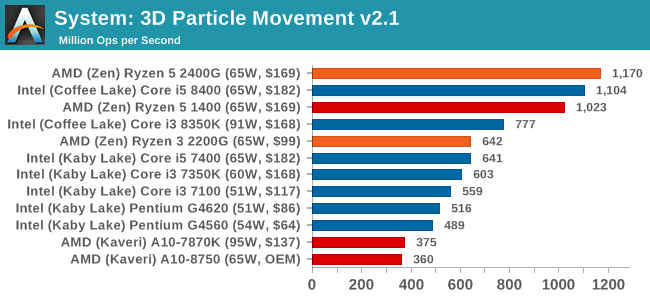
3DPM is our first multi-threaded test, and the Ryzen 5 2400G powers ahead over the 1400 due to frequency, and ahead the Core i3-8350K due to thread count. This is a benchmark that can take advantage of multithreading, so the quad-core APU with eight threads pushes ahead of the six-core Intel Core i5-8400.
DigiCortex v1.20: link
Despite being a couple of years old, the DigiCortex software is a pet project for the visualization of neuron and synapse activity in the brain. The software comes with a variety of benchmark modes, and we take the small benchmark which runs a 32k neuron/1.8B synapse simulation. The results on the output are given as a fraction of whether the system can simulate in real-time, so anything above a value of one is suitable for real-time work. The benchmark offers a 'no firing synapse' mode, which in essence detects DRAM and bus speed, however we take the firing mode which adds CPU work with every firing.
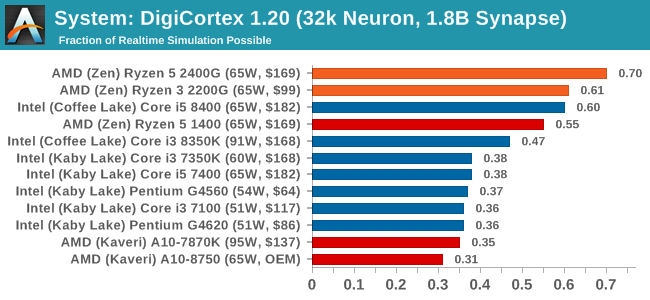
Agisoft Photoscan 1.3.3: link
Photoscan stays in our benchmark suite from the previous version, however now we are running on Windows 10 so features such as Speed Shift on the latest processors come into play. The concept of Photoscan is translating many 2D images into a 3D model - so the more detailed the images, and the more you have, the better the model. The algorithm has four stages, some single threaded and some multi-threaded, along with some cache/memory dependency in there as well. For some of the more variable threaded workload, features such as Speed Shift and XFR will be able to take advantage of CPU stalls or downtime, giving sizeable speedups on newer microarchitectures.
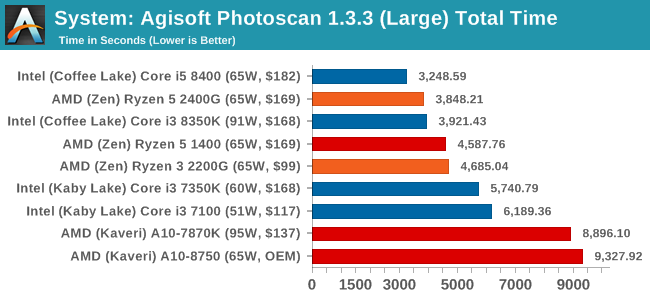
For Photoscan, certain elements of the algorithms require full cores to get the best performance, hence why the six-core CPU comes top and the Ryzen 5 2400G and Core i3-8350K are matched. That being said, the multithreading of the 2400G outweighs the extra frequency of the 8350K.










177 Comments
View All Comments
Lolimaster - Monday, February 12, 2018 - link
I would get the Asus X370 pro and the G.Skill Flare X 3200 CL14 (ram is expensive no matter how "cheap" you wanna go)coolhardware - Monday, February 12, 2018 - link
Thank you for the recommendation!!! :-)kaidenshi - Tuesday, February 13, 2018 - link
I'm using the ASRock AB350M Pro4 with a Ryzen 3 1300X, 16GB Crucial Ballistix 2400MHz DDR4 memory, and a GTX 1060 SC. It's been a rock solid board so far, and it has two PCI-E storage slots (one is NVMe, the other is SATA) so you can use it comfortably in a case with limited storage options.I was nervous about it after I read some reviews on Newegg talking about stability issues, but it turned out pretty much all of those people were trying to overclock it far beyond its rated capabilities. It's perfectly stable if you don't try to burn it up on purpose.
Samus - Monday, February 12, 2018 - link
Seriously. It's now obvious why Intel is using AMD graphics. Considering that its mostly on par (sometimes faster, sometimes slower) with a GT 1030, a $100 GPU that uses 30 watts alone, Intel made the right choice using VEGA.Flunk - Monday, February 12, 2018 - link
Wow, that's some impressive numbers for the price point (either of them). I think the R5 2400G would cover the vast majority of users' CPU and GPU needs to the point where they wouldn't notice a difference from anything more expensive. Anyone short of a power user or hardcore gamer could buy one of these and feel like they'd bought a real high-end system, with a $169.99 CPU. That's real value. I kinda want one to play around with, I don't know how I'll justify that to myself... Maybe I'll give it to my father next Christmas.jjj - Monday, February 12, 2018 - link
Was hoping to see GPU OC perf and power, won't scale great unless the memory controller can take faster sticks (than Summit Ridge) but we still need to figure it all out.iter - Monday, February 12, 2018 - link
Most other sites' reviews feature overclocking and power.Ian Cutress - Monday, February 12, 2018 - link
I started an initial run with higher speed memory, but nothing substantial enough to put in the article just yet. I'm planning some follow ups.jjj - Monday, February 12, 2018 - link
Looking forward to all of that.Anyway, they do deliver here for folks that can't afford discrete or got other reasons to go with integrated. Even the 2400G is ok if one needs 8 threads.
Kamgusta - Monday, February 12, 2018 - link
Where is the i5-8400 that has the same price as the 2400G?Oh, yeah, they totally left it out from the benchmarks since it would have proved an absolute supremacy of the Intel offering.
Ops.